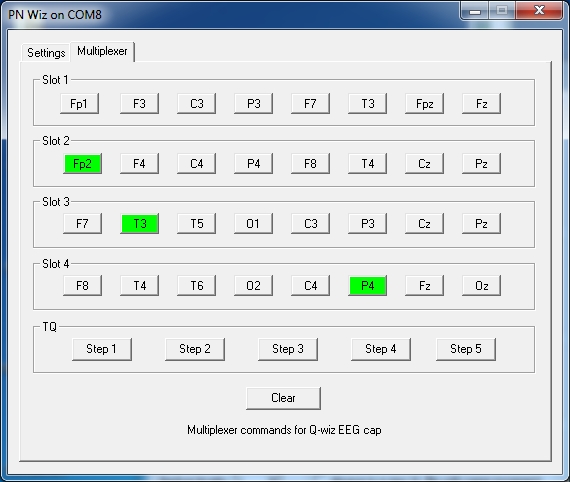BAL4C RH Bipolar | BioExplorer Q-wiz Electro-Cap
1. Connect amplifier to computer
Connect your amplifier cable into your amplifier and then to the computer’s USB port.
1. Open BioExplorer
USB dongle key must be plugged in.
2. Resize BioExplorer window
For quick access to PN Wiz window behind it
Open Training design
“BAL4C RH Bipolar”
1. Fill syringe with gel
Preparing to gel electrodes
2. Place cap on client’s head
Align electrodes to correct sites on scalp.
Gel electrodes
Apply gel to all electrodes that will be used: AFz, C4, Fp2, T3, P4, T4. Push the end of the syringe plunger so that the gel gets squeezed out of the needle into the electrode’s hole (white circle with hole on cap).
Leave both ear clips disconnected
Unplug both ear drops from the cap. Leaving them dangling would pick up frequencies from the room, which we do not want.
Connect electrode cap to amplifier
1. Select Wiz settings
Check power, references, mode

2. Select Wiz Multiplexer sites
Control the sites (places on head) being trained Leave Slot 1 empty.

1. Connect Quick Insert electrode to active site C4
Plug the little metal tip of the long white electrode wire into the C4 electrode (white circle with hole on the cap).
2. Connect Quick Insert to Q-wiz Channel 1 port
Plug the thick end of the long white electrode wire into the 1+ port (hole) on the Q-wiz.
1. Connect Quick Insert electrode to reference site T4
Plug the little metal tip of the long white electrode wire into the T4 electrode (white circle with hole on the cap).
2. Connect Quick Insert to Q-wiz Channel 1 reference port
Plug the thick end of the long white electrode wire into the 1- port (hole) on the Q-wiz. This single common reference will serve for all 4 channels.
Start Session with Eyes Open with Video Feedback
1. Turn MIDI music off
Press “Music is On” buton so it reads “Music is Off”
2. Explain process to client
Keep eyes open, listen to the music and watch the video. In the beginning, where most pieces start with a single voice, one can see how the visual matches the audio, moving up and down and using longer or shorter notes. Then, when the second musical voice appears, the video adds a second line of a different color, and the client can follow how they work together, etc. It’s not about “understanding”, but about seeing and hearing and letting the brain make the connection, just enjoying the music.
3. Press Capture (green triangle) and check signal quality
Train for about 6 minutes. This is two of the shorter fugues or one longer fugue (e.g. Great Fugue).